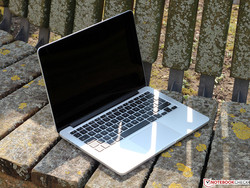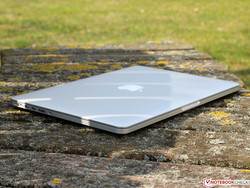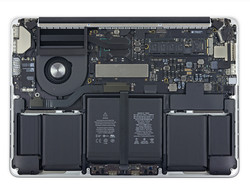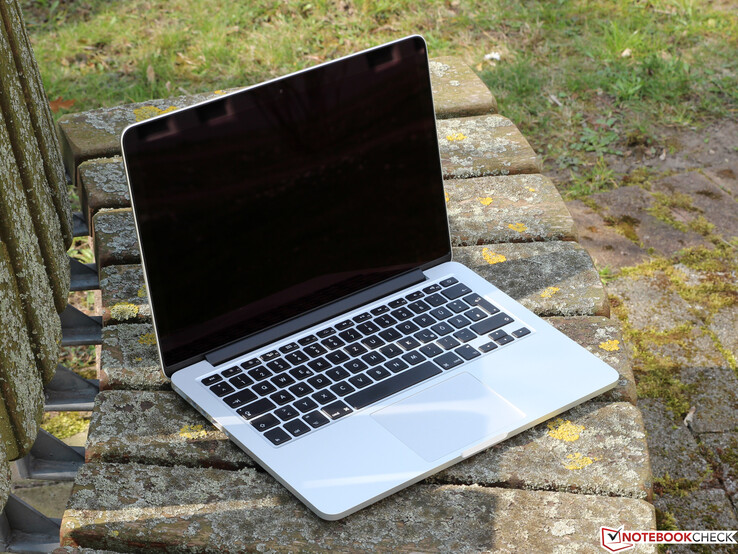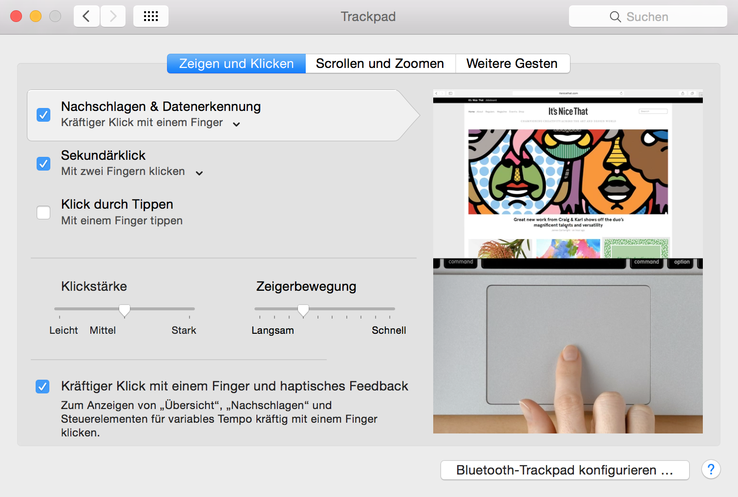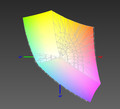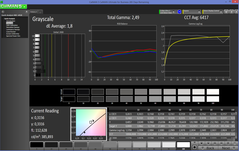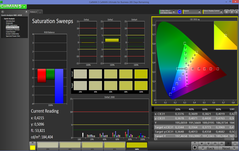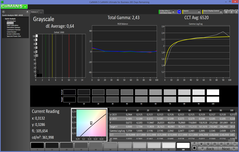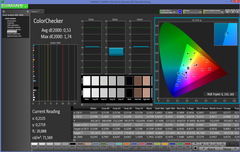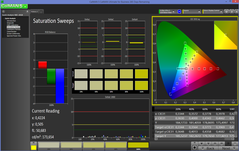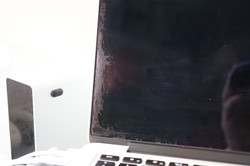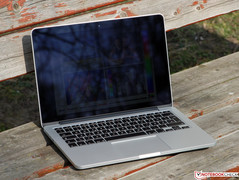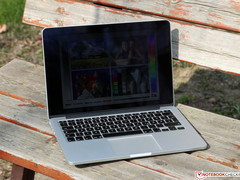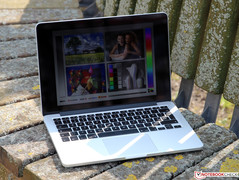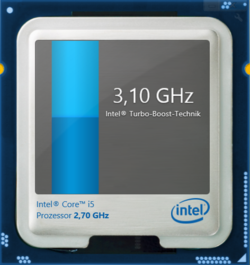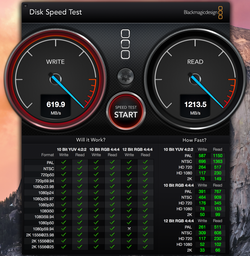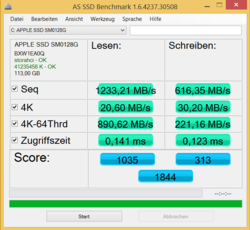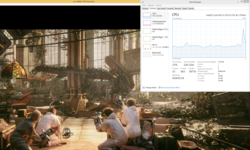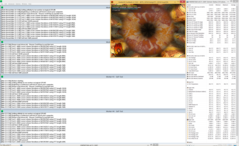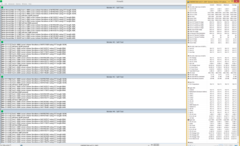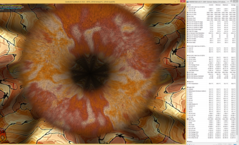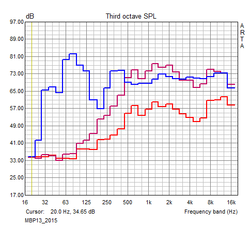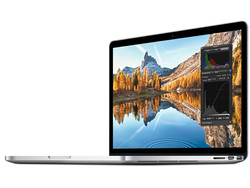Apple MacBook Pro Retina 13 (Early 2015) Notebook Review

For the original German review, see here.
It is probably the best subnotebook on the market for many users: Apple's MacBook Pro 13 Retina. Especially the combination of excellent mobility, great performance and a flawless build quality that is typical for Apple ensured the 13-inch device a top spot in our corresponding Top 10 ranking in the end of 2013.
There is a new version of the "MBP 13" since the beginning of this year and we will have a closer look at it in this review. The main attraction is the updated hardware platform based on the Intel Broadwell generation, whose improved power efficiency should result in even longer runtimes. Furthermore, the manufacturer introduced other small improvements, starting with the new Force Touch trackpad up to an SSD that is twice as fast, according to Apple.
That a MacBook is not really the cheapest entry into the notebook world should not surprise anybody. However, potential buyers will have to pay even more this year – Apple increased the prices significantly because of the very weak Euro right now. Our review unit, for example, with a Core i5-5257U, 8 GB RAM and a 128 GB SSD costs a pretty hefty 1,449 Euros (~$1577), and the high-end configuration (Core i7/16 GB/1 TB) retails for more than 3,000 Euros (~$3265). You can save some bucks compared to the official Apple prices at some retailers, but the MBP 13 is an expensive device nonetheless.
Case, Connectivity, & Communication
Since the chassis and the ports are identical to the predecessor, we won't cover them extensively once again. All the corresponding information is available in our unboxing and test video on YouTube as well as the previous review article.
The MacBook is still the benchmark for all the rivals in respect of the quality. Although there are many high-quality Ultrabooks with Windows nowadays, not many can actually reach the level of Apple. The chassis, which is milled from a single piece of aluminum, is not the lightest of its kind with 1.6 kg, but the stability is excellent in return and you probably get the most precise display hinges in this class. Our critical eyes could not find any build quality flaws, but we can still notice the very limited upgradeability. The specialists from iFixit only rated the MacBook with 1 out of 10 possible points.
The highlights of the port variety are the two Thunderbolt 2 ports (also usable as Mini-DisplayPort, up to 4K @ 60 Hz); in addition you get two USB 3.0 ports as well as one HDMI port (4K @ 24 Hz). This means the MBP can be used as a real working device – one ambition that does not apply for the slimmed down Air-series or the new 12-inch MacBook. The wireless connectivity includes the usual features like Bluetooth 4.0 as well as WLAN 802.11 ac. Apple uses a particularly fast triple-stream adaptor from Broadcom.
The BCM94360CS reaches an enormous theoretical transfer rate of 1.3 Gbps, but the module did not work very well with our TP-Link Archer C7 and we did not manage more than 100 Mbps at first. A firmware update, however, improved the situation and the transfer rate was increased to almost 580 Mbps or 65 MB/s, respectively – a record result and the Broadcom chip can beat common dual-stream solutions like Intel's Wireless-AC 7265 by around 50%.
(Some pictures show the predecessor with the identical exterior)
The new Force Touch Trackpad
The new Force Touch trackpad is probably the most innovative new feature of the 2015 MacBooks. Dimensions and the surface are completely identical to the previous solution – the actual highlight is the construction underneath. While a classic ClickPad uses some kind of hinge and can only be clicked at the lower half as a result, Apple's pad lies flat on the underground. This means nothing happens when you try to click it while the device is turned off.
While the device is running, however, sensors analyze the pressure from the fingers of the user. If they register an input, the pad simulates a slight physical deflection via electromagnets and even creates the typical clicking noise. This trick feels so realistic in practice that you think you actually use a normal touchpad – with a slightly short travel – and a very crisp pressure point.
But what are the advantages of this construction, which is certainly very complex? Well: First of all, the pad can be clicked on the whole surface, which allows Drag & Drop operations with just one finger. But the notebook can also execute different actions depending on the applied pressure. Apple invented the so called Force Click for this purpose, which can be triggered with a high amount of pressure and is also accompanied with a second click (haptic/acoustic). You can search for terms in texts of websites with the Force Click, edit file names in the Finder or show all the opened windows from an app in the dock.
The manufacturer created an overview about the numerous possibilities of the pad on the Internet – we found that some actions were pretty handy after a small learning period, but others are basically unnecessary gimmicks. It remains to be seen how applications from Apple and third-party companies will use the new feature.
Boot Camp & Windows 8.1
We still had some issues with the installation of Windows 8.1 via Boot Camp on the predecessor, but there were no major problems on the 2015 model: Copy the ISO file to a USB stick, set the size of the Windows partition, wait for the installation, done – the second OS is ready after around 30 minutes. All the hardware components, including touchpad (obviously without the Force Touch feature), are automatically recognized and installed, only some small details like pinch-to-zoom refused to work in our case. We will have a closer look at the problems when you use Windows on a MacBook in the following sections. By the way: Windows 7 as well as all 32-bit versions of the Microsoft OS are, unfortunately, not supported by Boot Camp anymore.
Display
Considering the recently introduced Dell XPS 13, which has a resolution of 3200x1800 pixels at the same display size, the 2560x1600 pixels of the MBP 13 appear much less impressive than one or two years ago. The Dell also has a tiny frame that allows very compact chassis dimensions and also looks unbelievably good.
You could, however, acknowledge that Apple found a good compromise in respect of the resolution: 227 PPI (XPS 13: 276 PPI) is more than enough to display even very small symbols and fonts sharply from a typical viewing distance. If you run older Windows applications via Boot Camp, you will face scaling issues quite often that would even be worse with higher resolutions. You should not forget the very high power consumption of displays with extremely high resolutions, either.
The maximum brightness of the panel is roughly identical to our last review with 342 cd/m² – which means the MacBook is on a level with the rivals from Asus (UX303LN: 339 cd/m²) and Dell (XPS 13: 372 cd/m²). That the brightness distribution is not completely even but slightly decreases from the right to the left side, is hardly visible with the eye. Even the typical worst-case scenario – a black picture with the maximum brightness in a dark room – is no problem for the panel and you get a very uniform result. We could not determine annoying PWM flickering.
| |||||||||||||||||||||||||
Brightness Distribution: 81 %
Center on Battery: 360 cd/m²
Contrast: 1000:1 (Black: 0.361 cd/m²)
ΔE ColorChecker Calman: 1.82 | ∀{0.5-29.43 Ø4.79}
ΔE Greyscale Calman: 1.8 | ∀{0.09-98 Ø5}
96.9% sRGB (Argyll 1.6.3 3D)
61.9% AdobeRGB 1998 (Argyll 1.6.3 3D)
67.4% AdobeRGB 1998 (Argyll 3D)
97% sRGB (Argyll 3D)
65.9% Display P3 (Argyll 3D)
Gamma: 2.49
CCT: 6417 K
| Apple MBP 13 Early 2015 2560x1600; IPS | Dell XPS 13 3200x1800; IPS | Asus UX303LN 1920x1080; IPS | Acer Aspire R13 1920x1080; IPS | Apple MBP 13 Late 2013 2560x1600; IPS | |
|---|---|---|---|---|---|
| Display | 5% | ||||
| Display P3 Coverage (%) | 65.9 | 72 9% | |||
| sRGB Coverage (%) | 97 | 96 -1% | |||
| AdobeRGB 1998 Coverage (%) | 67.4 | 71.6 6% | |||
| Response Times | |||||
| Response Time Grey 50% / Grey 80% * (ms) | 33 ? | ||||
| Response Time Black / White * (ms) | 26.2 ? | ||||
| PWM Frequency (Hz) | |||||
| Screen | -25% | -32% | -37% | -11% | |
| Brightness middle (cd/m²) | 361 | 367.3 2% | 376 4% | 316 -12% | 327 -9% |
| Brightness (cd/m²) | 342 | 372 9% | 368 8% | 305 -11% | 300 -12% |
| Brightness Distribution (%) | 81 | 77 -5% | 88 9% | 90 11% | 84 4% |
| Black Level * (cd/m²) | 0.361 | 0.178 51% | 0.7 -94% | 0.23 36% | 0.42 -16% |
| Contrast (:1) | 1000 | 2063 106% | 537 -46% | 1374 37% | 779 -22% |
| Colorchecker dE 2000 * | 1.82 | 5.92 -225% | 3.09 -70% | 4.21 -131% | |
| Colorchecker dE 2000 max. * | 3.26 | ||||
| Greyscale dE 2000 * | 1.8 | 4.79 -166% | 2.4 -33% | 5.16 -187% | |
| Gamma | 2.49 88% | 2.42 91% | 2.24 98% | 2.58 85% | |
| CCT | 6417 101% | 7013 93% | 6781 96% | 6934 94% | |
| Color Space (Percent of AdobeRGB 1998) (%) | 61.9 | 63 2% | |||
| Color Space (Percent of sRGB) (%) | 96.9 | 96.4 -1% | |||
| Total Average (Program / Settings) | -10% /
-18% | -32% /
-32% | -37% /
-37% | -11% /
-11% |
* ... smaller is better
Apple did not make any compromises in regard to the panel and still uses a high-quality IPS screen. It is probably the same (or a very similar) model from the predecessor; at least the similar measurement results suggest that. The rich black value of just 0.36 cd/m² results in a contrast ratio of exactly 1,000:1 – a very decent result, even though the XPS 13 is even better. Still, there won't be a big subjective difference with such high results.
The MacBook-series is a very popular choice amongst photographers as well as graphics artists, and not without a reason: The devices from Cupertino have convinced with accurate colors for years now. The new MBP 13 confirms those high expectations with impressively low DeltaE deviations, which can even be further reduced with a calibration. The important sRGB standard is covered by 97% (Correction 20.5.2015 due to a wrong sRGB-reference-profile) and the bigger AdobeRGB color space by 61.9%.
Although we would generally say it is a glare panel, there are not as many reflections compared to most rivals. This is probably a result of the special surface coating, even though it actually produced some negative news recently: The phenomenon is called "Staingate" and hundreds of users on the Internet have complained about glossy stains and discolorations that appear after less than a year and then start to grow. You cannot really trust the manufacturer's warranty in this case – Apple often says it is a cosmetic problem and offers affected users a repair for around $800. A MacBook Pro Retina 13 in our editorial office, which was purchased in autumn 2013, is affected as well. It remains to be seen whether the 2015 generation will have these issues as well.
Apart from this issue, the surface, which reduces the reflections, is pretty useful and ensures the visibility of the display content even under the sky. Only direct sunlight should be avoided – the LED backlight with more than 300 cd/m² is just not bright enough.
Outdoor use (midday sun)
Not every IPS panel is similar: Displays with this technology are generally known for their good viewing-angle stability, but there are actually pretty big differences between the individual models. The panel in the MBP 13 is at the highest level in this respect and hardly shows any deviation in terms of contrast or the colors, even with very flat angles. You can clearly see a difference compared to the slightly less expensive rivals like the Asus Zenbook UX303LN.
Performance
13-inch subnotebooks almost exclusively use ULV CPUs with a TDP of 15 Watts nowadays. They result in good battery runtimes; the performance, however, is not really outstanding. The MacBook Pro 13 uses an Intel Broadwell processor with a TDP of 28 Watts, which suggests bigger performance reserves, especially when you stress the CPU and the GPU at the same time.
The Core i5-5257U in our entry-level configuration has a nominal clock of 2.7 GHz, which can be increased up to 3.1 GHz via Turbo Boost. Apple also offers an optional upgrade to a Core i5-5287U (2.9 - 3.3 GHz, 100 Euros more, ~$108) or Core i7-5557U (3.1 - 3.4 GHz, 350 Euros more, ~$380). Apart from the clock differences as well as the slightly bigger L3 cache of the i7 version, however, the models hardly differ at all: All three chips have two CPU cores each and support Hyper-Threading to execute up to four threads simultaneously.
Since there is no dedicated graphics card (unlike the Asus UX303LN, for example), all 3D calculations are handled by the integrated Iris Graphics 6100. Compared to the old Iris Graphics 5100, Intel has increased the number of Execution Units (EUs) from 40 to 48 for the new chip, so the shader performance is roughly twice as high as the popular HD Graphics 5500 (24 EUs). Still, based on our experiences (at least for Intel GPUs from the last couple of years), the frame rate does not scale according to the theoretical performance.
One reason for this is the limited memory bandwidth. Both the processor and the graphics unit are still attached via a small 128-bit interface (2x 64-bit dual-channel) in the Broadwell generation, but Intel now allows – at least for the 28-watt models – slightly higher clocks up to LPDDR3-1866. Apple either solders 8 or 16 GB to the motherboard, the latter for a hefty additional charge of 200 Euros (~$217). Just as expensive is the upgrade of the 128 GB SSD; 200 Euros (~$217) for 256 GB or 450 Euros (~$489) for 512 GB (adjusted for differences in equipment), respectively, are a bit too expensive in our opinion.
| Core i5-5257U | Core i5-5287U | Core i7-5557U | Core i5-4258U | |
|---|---|---|---|---|
| Architecture | Broadwell | Broadwell | Broadwell | Haswell |
| Manufacturing | 14 nm | 14 nm | 14 nm | 22 nm |
| Clocks | 2.7 - 3.1 GHz | 2.9 - 3.3 GHz | 3.1 - 3.4 GHz | 2.4 - 2.9 GHz |
| Cores/Threads | 2/4 | 2/4 | 2/4 | 2/4 |
| L3 Cache | 3 MB | 3 MB | 4 MB | 3 MB |
| Graphics | Iris Graphics 6100 48 EUs, 300 - 1050 MHz |
Iris Graphics 6100 48 EUs, 300 - 1100 MHz |
Iris Graphics 6100 48 EUs, 300 - 1100 MHz |
Iris Graphics 5100 40 EUs, 200 - 1100 MHz |
| Memory Controller | Dual-Channel 1866 MHz | Dual-Channel 1866 MHz | Dual-Channel 1866 MHz | Dual-Channel 1600 MHz |
System information Apple MacBook Pro Retina 13
Processor
The combination of increased clocks and slightly improved per-MHz performance results in an advantage of around 10 - 15% for the Core i5-5257U over the previous Core i5-4258U. This is pretty much on the performance level of the Core i5-4310M or Core i5-4200H, both of which have a much higher specified TDP of 37 and 47 Watts, respectively. It is interesting that the benchmark results under Windows 8.1 are repeatedly higher compared to OS X – we suggest that Apple chose a more defensive approach for the Turbo Boost to improve the power efficiency. The performance on mains and battery power is identical with both systems.
Another interesting aspect is the comparison of the Core i5-5257U with the Core i7-5500U inside the Zenbook UX303LN. The "small" 15-watt model is surprisingly close to the 5257U, although it is only surprising at first: Thanks to the advanced 14 nm manufacturing process, the real power consumption in CPU benchmarks like Cinebench is clearly below 20 Watts, so a higher TDP classification hardly makes a difference. It is unfortunate that Intel does not offer quad-core models in the (U)LV segment yet (except for the Atom chips) – four lower-clocked cores would certainly be more efficient than an extremely fast dual-core CPU in multi-threaded applications.
| Cinebench R11.5 | |
| CPU Single 64Bit (sort by value) | |
| Apple MacBook Pro Retina 13 inch 2015-03 | |
| Apple MacBook Pro Retina 13 inch 2015-03 | |
| Asus Zenbook UX303LN-R4274H | |
| Dell XPS 13 9343 Core i7 | |
| Lenovo Yoga 3 Pro | |
| Apple MacBook Pro Retina 13 inch 2013-10 | |
| Apple MacBook Pro Retina 15 inch 2013-10 | |
| CPU Multi 64Bit (sort by value) | |
| Apple MacBook Pro Retina 13 inch 2015-03 | |
| Apple MacBook Pro Retina 13 inch 2015-03 | |
| Asus Zenbook UX303LN-R4274H | |
| Dell XPS 13 9343 Core i7 | |
| Lenovo Yoga 3 Pro | |
| Apple MacBook Pro Retina 13 inch 2013-10 | |
| Apple MacBook Pro Retina 15 inch 2013-10 | |
| Cinebench R15 | |
| CPU Single 64Bit (sort by value) | |
| Apple MacBook Pro Retina 13 inch 2015-03 | |
| Asus Zenbook UX303LN-R4274H | |
| Dell XPS 13 9343 Core i7 | |
| Lenovo Yoga 3 Pro | |
| Apple MacBook Pro Retina 13 inch 2013-10 | |
| Apple MacBook Pro Retina 15 inch 2013-10 | |
| CPU Multi 64Bit (sort by value) | |
| Apple MacBook Pro Retina 13 inch 2015-03 | |
| Asus Zenbook UX303LN-R4274H | |
| Dell XPS 13 9343 Core i7 | |
| Lenovo Yoga 3 Pro | |
| Apple MacBook Pro Retina 13 inch 2013-10 | |
| Apple MacBook Pro Retina 15 inch 2013-10 | |
| X264 HD Benchmark 4.0 | |
| Pass 1 (sort by value) | |
| Apple MacBook Pro Retina 13 inch 2015-03 | |
| Lenovo Yoga 3 Pro | |
| Apple MacBook Pro Retina 13 inch 2013-10 | |
| Pass 2 (sort by value) | |
| Apple MacBook Pro Retina 13 inch 2015-03 | |
| Lenovo Yoga 3 Pro | |
| Apple MacBook Pro Retina 13 inch 2013-10 | |
Storage Devices
Apple already replaced classic SATA-SSDs a while ago and the manufacturer uses the much faster PCIe-interface instead. While SATA-III limits the net transfer rates to a little under 600 MB/s, PCIe 3.0 x4 almost reaches 4 GB/s.
Although our 128 GB drive has the designation "Apple SSD SM0128G," it is probably the Samsung SM951 (maybe with a customized firmware) that was just recently launched. This M.2 SSD (2280) is based on the Samsung S4LN058A01 controller in combination with 19 nm MLC NAND and 512 MB LPDDR3 cache.
Since there are no limitations from the interface, we can see sequential transfer rates of up to 1,200 MB/s (reading) and around 600 MB/s (writing) – the highest results that we determined for a single drive with this capacity so far. Slightly disappointing, however, are the results for the 4K tests, where the Apple/Samsung SSD is actually slower than several SATA rivals. This small weakness is only overcome with heavily parallelized accesses and the MacBook can secure the top spot within the competition.
| Apple MacBook Pro Retina 13 (Early 2015) | Dell XPS 13-9343 | Asus Zenbook UX303LN | Acer Aspire R13 | Apple MacBook Pro Retina 13 (Late 2013) | |
|---|---|---|---|---|---|
| AS SSD | 2% | 16% | 11% | -24% | |
| Seq Write (MB/s) | 616 | 416.8 -32% | 421 -32% | 659 7% | 592 -4% |
| Seq Read (MB/s) | 1233 | 484.7 -61% | 480.1 -61% | 411.6 -67% | 711 -42% |
| 4K Read (MB/s) | 20.6 | 30.89 50% | 30.65 49% | 31.97 55% | 16.2 -21% |
| 4K Write (MB/s) | 30.2 | 58.8 95% | 83.1 175% | 66.4 120% | 19.8 -34% |
| 4K-64 Read (MB/s) | 891 | 345.5 -61% | 349.3 -61% | 350.6 -61% | 441 -51% |
| 4K-64 Write (MB/s) | 221.2 | 268.3 21% | 275.9 25% | 246.1 11% | 238 8% |
System Performance
The MBP 13 dominates all system benchmarks of the PCMark-series, not least because of the outstanding SSD performance. Still, we want to mention that those results cannot really be transferred to real-world usage: Performance differences between different SSDs are hardly noticeable in practice, an XPS 13 or UX303LN at least do not feel slower. The marginally higher performance of the 28-watt processor also results in a slight disappointment – on a high level. Very demanding users that use CPU-heavy software or excessive multi-tasking are probably better off with an MBP 15 and its quad-core i7. This is obviously the case for comparable Windows devices as well.
Still, the MacBook Pro 13 is generally one of the fastest subnotebooks on the market and handles typical office, multimedia and web applications without noticeable problems.
| PCMark 7 - Score (sort by value) | |
| Apple MacBook Pro Retina 13 inch 2015-03 | |
| Dell XPS 13-9343 | |
| Asus Zenbook UX303LN-R4141H | |
| Acer Aspire R13 R7-371T-779K | |
| Apple MacBook Pro Retina 13 inch 2013-10 | |
| PCMark 8 | |
| Home Score Accelerated v2 (sort by value) | |
| Apple MacBook Pro Retina 13 inch 2015-03 | |
| Dell XPS 13-9343 | |
| Asus Zenbook UX303LN-R4141H | |
| Acer Aspire R13 R7-371T-779K | |
| Creative Score Accelerated v2 (sort by value) | |
| Apple MacBook Pro Retina 13 inch 2015-03 | |
| Dell XPS 13-9343 | |
| Asus Zenbook UX303LN-R4141H | |
| Work Score Accelerated v2 (sort by value) | |
| Apple MacBook Pro Retina 13 inch 2015-03 | |
| Dell XPS 13-9343 | |
| Asus Zenbook UX303LN-R4141H | |
| Acer Aspire R13 R7-371T-779K | |
| PCMark 7 Score | 5620 points | |
| PCMark 8 Home Score Accelerated v2 | 3363 points | |
| PCMark 8 Creative Score Accelerated v2 | 4593 points | |
| PCMark 8 Work Score Accelerated v2 | 4105 points | |
Help | ||
Graphics
We already talked about the specifications of the Iris Graphics 6100, now we want to have a look at the performance results. However, we do not get a very uniform picture: While the GPU is around 50% ahead of the HD Graphics 5500 and Iris Graphics 5100 in 3DMark 11, the advantage drops to 10 up to 20% in 3DMark 2013, which benefits from more memory bandwidth. It is possible that the current (Windows) drivers cannot utilize the full potential; but it seems that the Iris Graphics 6100 cannot compete with a GeForce 840M. An upgrade to the Core i5-5287U or Core i7-5557U – both with slightly higher CPU and GPU clocks – won't really change that.
As expected, the GPU can handle all our multimedia tests without problems. Even a 4K video in the H.265 codec runs smoothly with reasonable CPU load; at least if you have installed a corresponding video player with working hardware acceleration. It is recommended to use the very efficient Quick Sync unit of the processor (with Handbrake, for example) if you want to encode and transcode movies.
| 3DMark 11 | |
| 1280x720 Performance (sort by value) | |
| Apple MacBook Pro Retina 13 inch 2015-03 | |
| Dell XPS 13 9343 Core i7 | |
| Asus Zenbook UX303LN-R4274H | |
| Acer Aspire R13 R7-371T-779K | |
| Apple MacBook Pro Retina 13 inch 2013-10 | |
| Lenovo ThinkPad T450s-20BWS03F00 | |
| 1280x720 Performance GPU (sort by value) | |
| Apple MacBook Pro Retina 13 inch 2015-03 | |
| Dell XPS 13 9343 Core i7 | |
| Asus Zenbook UX303LN-R4274H | |
| Acer Aspire R13 R7-371T-779K | |
| Apple MacBook Pro Retina 13 inch 2013-10 | |
| Lenovo ThinkPad T450s-20BWS03F00 | |
| 3DMark | |
| 1280x720 Cloud Gate Standard Score (sort by value) | |
| Apple MacBook Pro Retina 13 inch 2015-03 | |
| Dell XPS 13 9343 Core i7 | |
| Asus Zenbook UX303LN-R4274H | |
| Acer Aspire R13 R7-371T-779K | |
| Apple MacBook Pro Retina 13 inch 2013-10 | |
| Lenovo ThinkPad T450s-20BWS03F00 | |
| 1280x720 Cloud Gate Standard Graphics (sort by value) | |
| Apple MacBook Pro Retina 13 inch 2015-03 | |
| Dell XPS 13 9343 Core i7 | |
| Asus Zenbook UX303LN-R4274H | |
| Acer Aspire R13 R7-371T-779K | |
| Apple MacBook Pro Retina 13 inch 2013-10 | |
| Lenovo ThinkPad T450s-20BWS03F00 | |
| 1920x1080 Fire Strike Score (sort by value) | |
| Apple MacBook Pro Retina 13 inch 2015-03 | |
| Dell XPS 13 9343 Core i7 | |
| Asus Zenbook UX303LN-R4274H | |
| Apple MacBook Pro Retina 13 inch 2013-10 | |
| Lenovo ThinkPad T450s-20BWS03F00 | |
| 1920x1080 Fire Strike Graphics (sort by value) | |
| Apple MacBook Pro Retina 13 inch 2015-03 | |
| Dell XPS 13 9343 Core i7 | |
| Asus Zenbook UX303LN-R4274H | |
| Apple MacBook Pro Retina 13 inch 2013-10 | |
| Lenovo ThinkPad T450s-20BWS03F00 | |
| GFXBench (DX / GLBenchmark) 2.7 - 1920x1080 T-Rex Offscreen (sort by value) | |
| Apple MacBook Pro Retina 13 inch 2015-03 | |
| Apple MacBook Pro Retina 13 inch 2013-10 | |
| Lenovo ThinkPad T450s-20BWS03F00 | |
| GFXBench 3.0 - 1920x1080 1080p Manhattan Offscreen (sort by value) | |
| Apple MacBook Pro Retina 13 inch 2015-03 | |
| Lenovo ThinkPad T450s-20BWS03F00 | |
| SPECviewperf 12 | |
| 1900x1060 Catia (catia-04) (sort by value) | |
| Apple MacBook Pro Retina 13 inch 2015-03 | |
| Lenovo ThinkPad T450s-20BWS03F00 | |
| 1900x1060 Creo (creo-01) (sort by value) | |
| Apple MacBook Pro Retina 13 inch 2015-03 | |
| Lenovo ThinkPad T450s-20BWS03F00 | |
| 1900x1060 Energy (energy-01) (sort by value) | |
| Apple MacBook Pro Retina 13 inch 2015-03 | |
| Lenovo ThinkPad T450s-20BWS03F00 | |
| 1900x1060 Maya (maya-04) (sort by value) | |
| Apple MacBook Pro Retina 13 inch 2015-03 | |
| 1900x1060 Medical (medical-01) (sort by value) | |
| Apple MacBook Pro Retina 13 inch 2015-03 | |
| Lenovo ThinkPad T450s-20BWS03F00 | |
| 1900x1060 Showcase (showcase-01) (sort by value) | |
| Apple MacBook Pro Retina 13 inch 2015-03 | |
| Lenovo ThinkPad T450s-20BWS03F00 | |
| 1900x1060 Siemens NX (snx-02) (sort by value) | |
| Apple MacBook Pro Retina 13 inch 2015-03 | |
| Lenovo ThinkPad T450s-20BWS03F00 | |
| 1900x1060 Solidworks (sw-03) (sort by value) | |
| Apple MacBook Pro Retina 13 inch 2015-03 | |
| Lenovo ThinkPad T450s-20BWS03F00 | |
| 3DMark 06 Standard Score | 9332 points | |
| 3DMark Vantage P Result | 6531 points | |
| 3DMark 11 Performance | 1828 points | |
| 3DMark Ice Storm Standard Score | 53847 points | |
| 3DMark Cloud Gate Standard Score | 6190 points | |
| 3DMark Fire Strike Score | 981 points | |
| 3DMark Fire Strike Extreme Score | 448 points | |
Help | ||
Gaming Performance
If you can live with reduced quality settings, then you can actually play many current titles smoothly with the MBP 13 with low settings. Our tests, however, confirm that the Iris Graphics 6100 cannot really utilize its higher shading performance in many titles – it is pretty rare that the HD Graphics 5500 or Iris Graphics 5100 (both have a similar performance) fall more than 15 up to 20% behind. A dedicated GeForce 840M is at least 40% faster on average.
Our benchmarks, which were all performed under Windows 8.1, created a mysterious problem multiple times: The display of the MacBook started flickering after we changed the resolution and we were able to see parts from the menu or the desktop for a brief moment. We could not notice this behavior under OS X, so we think it is caused by a faulty graphics driver. There was, unfortunately, no newer version at the time of writing.
| Tomb Raider | |
| 1024x768 Low Preset (sort by value) | |
| Apple MacBook Pro Retina 13 inch 2015-03 | |
| Acer Aspire V3-371-58DJ | |
| Dell Latitude E7450 | |
| Asus UX32LN | |
| Acer Aspire V 15 Nitro VN7-571G-56NX | |
| Lenovo IdeaPad Z50-70 (59427656) | |
| Apple MacBook Pro Retina 13 inch 2013-10 | |
| Asus Zenbook UX301 | |
| Schenker S413 | |
| 1366x768 Normal Preset AA:FX AF:4x (sort by value) | |
| Apple MacBook Pro Retina 13 inch 2015-03 | |
| Acer Aspire V3-371-58DJ | |
| Dell Latitude E7450 | |
| Asus UX32LN | |
| Acer Aspire V 15 Nitro VN7-571G-56NX | |
| Lenovo IdeaPad Z50-70 (59427656) | |
| Apple MacBook Pro Retina 13 inch 2013-10 | |
| Asus Zenbook UX301 | |
| Schenker S413 | |
| 1366x768 High Preset AA:FX AF:8x (sort by value) | |
| Apple MacBook Pro Retina 13 inch 2015-03 | |
| Acer Aspire V3-371-58DJ | |
| Dell Latitude E7450 | |
| Asus UX32LN | |
| Acer Aspire V 15 Nitro VN7-571G-56NX | |
| Lenovo IdeaPad Z50-70 (59427656) | |
| Apple MacBook Pro Retina 13 inch 2013-10 | |
| Asus Zenbook UX301 | |
| Schenker S413 | |
| The Elder Scrolls V: Skyrim | |
| 1280x720 Low Preset (sort by value) | |
| Apple MacBook Pro Retina 13 inch 2015-03 | |
| Asus Zenbook UX301 | |
| Schenker S413 | |
| 1366x768 Medium Preset AA:4x (sort by value) | |
| Apple MacBook Pro Retina 13 inch 2015-03 | |
| Asus Zenbook UX301 | |
| Schenker S413 | |
| 1366x768 High Preset AA:8x AF:8x (sort by value) | |
| Apple MacBook Pro Retina 13 inch 2015-03 | |
| Asus Zenbook UX301 | |
| Schenker S413 | |
| Diablo III | |
| 1024x768 Low / off (sort by value) | |
| Apple MacBook Pro Retina 13 inch 2015-03 | |
| Dell Latitude E7450 | |
| Asus UX32LN | |
| Asus Zenbook UX301 | |
| Schenker S413 | |
| 1366x768 Medium / low (sort by value) | |
| Apple MacBook Pro Retina 13 inch 2015-03 | |
| Dell Latitude E7450 | |
| Asus UX32LN | |
| Asus Zenbook UX301 | |
| Schenker S413 | |
| 1366x768 High AA:on (sort by value) | |
| Apple MacBook Pro Retina 13 inch 2015-03 | |
| Dell Latitude E7450 | |
| Asus UX32LN | |
| Asus Zenbook UX301 | |
| Schenker S413 | |
| Counter-Strike: GO | |
| 1024x768 (Very) Low (sort by value) | |
| Apple MacBook Pro Retina 13 inch 2015-03 | |
| Dell Latitude E7450 | |
| Asus Zenbook UX301 | |
| Schenker S413 | |
| 1366x768 Medium (sort by value) | |
| Apple MacBook Pro Retina 13 inch 2015-03 | |
| Dell Latitude E7450 | |
| Asus Zenbook UX301 | |
| Schenker S413 | |
| 1366x768 High AA:2x MS AF:4x (sort by value) | |
| Apple MacBook Pro Retina 13 inch 2015-03 | |
| Dell Latitude E7450 | |
| Asus Zenbook UX301 | |
| Schenker S413 | |
| Metro: Last Light | |
| 1024x768 Low (DX10) AF:4x (sort by value) | |
| Apple MacBook Pro Retina 13 inch 2015-03 | |
| Acer Aspire V3-371-58DJ | |
| Asus UX32LN | |
| Asus Zenbook UX301 | |
| Schenker S413 | |
| 1366x768 Medium (DX10) AF:4x (sort by value) | |
| Apple MacBook Pro Retina 13 inch 2015-03 | |
| Acer Aspire V3-371-58DJ | |
| Asus UX32LN | |
| Asus Zenbook UX301 | |
| Schenker S413 | |
| 1366x768 High (DX11) AF:16x (sort by value) | |
| Apple MacBook Pro Retina 13 inch 2015-03 | |
| Acer Aspire V3-371-58DJ | |
| Asus UX32LN | |
| Asus Zenbook UX301 | |
| Schenker S413 | |
| Company of Heroes 2 | |
| 1024x768 Minimum / Low / Off AA:Off (sort by value) | |
| Apple MacBook Pro Retina 13 inch 2015-03 | |
| Acer Aspire V3-371-58DJ | |
| Acer Aspire V3-371-58DJ | |
| Lenovo IdeaPad Z50-70 (59427656) | |
| Apple MacBook Pro Retina 13 inch 2013-10 | |
| Asus Zenbook UX301 | |
| Schenker S413 | |
| 1366x768 Medium AA:Off (sort by value) | |
| Acer Aspire V3-371-58DJ | |
| Acer Aspire V3-371-58DJ | |
| Lenovo IdeaPad Z50-70 (59427656) | |
| Apple MacBook Pro Retina 13 inch 2013-10 | |
| Asus Zenbook UX301 | |
| Schenker S413 | |
| 1366x768 High AA:Medium (sort by value) | |
| Asus Zenbook UX301 | |
| Schenker S413 | |
| Dota 2 | |
| 1024x768 Low / Off, Render Quality: 40 % (sort by value) | |
| Apple MacBook Pro Retina 13 inch 2015-03 | |
| Dell Latitude E7450 | |
| Asus UX32LN | |
| Lenovo IdeaPad Z50-70 (59427656) | |
| Asus Zenbook UX301 | |
| 1366x768 Medium / On, Render Quality: 70 % (sort by value) | |
| Apple MacBook Pro Retina 13 inch 2015-03 | |
| Dell Latitude E7450 | |
| Asus UX32LN | |
| Lenovo IdeaPad Z50-70 (59427656) | |
| Asus Zenbook UX301 | |
| 1920x1080 High / On, Render Quality: 100 % (sort by value) | |
| Apple MacBook Pro Retina 13 inch 2015-03 | |
| Dell Latitude E7450 | |
| Asus UX32LN | |
| Lenovo IdeaPad Z50-70 (59427656) | |
| Asus Zenbook UX301 | |
| Battlefield 4 | |
| 1024x768 Low Preset (sort by value) | |
| Apple MacBook Pro Retina 13 inch 2015-03 | |
| Acer Aspire V3-371-58DJ | |
| Apple MacBook Pro Retina 13 inch 2013-10 | |
| 1366x768 Medium Preset (sort by value) | |
| Apple MacBook Pro Retina 13 inch 2015-03 | |
| Acer Aspire V3-371-58DJ | |
| Apple MacBook Pro Retina 13 inch 2013-10 | |
| 1366x768 High Preset (sort by value) | |
| Apple MacBook Pro Retina 13 inch 2015-03 | |
| Acer Aspire V3-371-58DJ | |
| Apple MacBook Pro Retina 13 inch 2013-10 | |
| Thief | |
| 1024x768 Very Low Preset (sort by value) | |
| Apple MacBook Pro Retina 13 inch 2015-03 | |
| Acer Aspire V3-371-58DJ | |
| Dell Latitude E7450 | |
| Acer Aspire V 15 Nitro VN7-571G-56NX | |
| Asus Zenbook UX303LN-R4141H | |
| Lenovo IdeaPad Z50-70 (59427656) | |
| Apple MacBook Pro Retina 13 inch 2013-10 | |
| 1366x768 Normal Preset AA:FX (sort by value) | |
| Apple MacBook Pro Retina 13 inch 2015-03 | |
| Acer Aspire V3-371-58DJ | |
| Dell Latitude E7450 | |
| Acer Aspire V 15 Nitro VN7-571G-56NX | |
| Asus Zenbook UX303LN-R4141H | |
| Apple MacBook Pro Retina 13 inch 2013-10 | |
| 1366x768 High Preset AA:FXAA & Low SS AF:4x (sort by value) | |
| Apple MacBook Pro Retina 13 inch 2015-03 | |
| Acer Aspire V3-371-58DJ | |
| Dell Latitude E7450 | |
| Acer Aspire V 15 Nitro VN7-571G-56NX | |
| Asus Zenbook UX303LN-R4141H | |
| Apple MacBook Pro Retina 13 inch 2013-10 | |
| GRID: Autosport | |
| 1024x768 Ultra Low Preset (sort by value) | |
| Apple MacBook Pro Retina 13 inch 2015-03 | |
| Acer Aspire V3-371-58DJ | |
| Lenovo IdeaPad Z50-70 (59427656) | |
| Apple MacBook Pro Retina 13 inch 2013-10 | |
| Schenker S413 | |
| 1366x768 Medium Preset (sort by value) | |
| Apple MacBook Pro Retina 13 inch 2015-03 | |
| Acer Aspire V3-371-58DJ | |
| Lenovo IdeaPad Z50-70 (59427656) | |
| Apple MacBook Pro Retina 13 inch 2013-10 | |
| Schenker S413 | |
| 1920x1080 High Preset (sort by value) | |
| Apple MacBook Pro Retina 13 inch 2015-03 | |
| Acer Aspire V3-371-58DJ | |
| Lenovo IdeaPad Z50-70 (59427656) | |
| Apple MacBook Pro Retina 13 inch 2013-10 | |
| Schenker S413 | |
| Sims 4 | |
| 1024x768 Low Preset (sort by value) | |
| Apple MacBook Pro Retina 13 inch 2015-03 | |
| Acer Aspire V3-371-58DJ | |
| Dell Latitude E7450 | |
| Asus Zenbook UX303LN-R4141H | |
| Schenker S413 | |
| 1366x768 Medium Preset (sort by value) | |
| Apple MacBook Pro Retina 13 inch 2015-03 | |
| Acer Aspire V3-371-58DJ | |
| Dell Latitude E7450 | |
| Asus Zenbook UX303LN-R4141H | |
| Schenker S413 | |
| 1920x1080 High Preset (sort by value) | |
| Apple MacBook Pro Retina 13 inch 2015-03 | |
| Acer Aspire V3-371-58DJ | |
| Dell Latitude E7450 | |
| Asus Zenbook UX303LN-R4141H | |
| Schenker S413 | |
| Fifa 15 | |
| 1280x720 Low Preset (sort by value) | |
| Apple MacBook Pro Retina 13 inch 2015-03 | |
| Acer Aspire V3-371-58DJ | |
| Dell Latitude E7450 | |
| Acer Aspire V 15 Nitro VN7-571G-56NX | |
| Asus Zenbook UX303LN-R4141H | |
| Apple MacBook Pro Retina 13 inch 2013-10 | |
| Schenker S413 | |
| 1366x768 High Preset AA:2x MS (sort by value) | |
| Apple MacBook Pro Retina 13 inch 2015-03 | |
| Dell Latitude E7450 | |
| Acer Aspire V 15 Nitro VN7-571G-56NX | |
| Asus Zenbook UX303LN-R4141H | |
| Apple MacBook Pro Retina 13 inch 2013-10 | |
| Schenker S413 | |
| 1920x1080 High Preset AA:4x MS (sort by value) | |
| Apple MacBook Pro Retina 13 inch 2015-03 | |
| Acer Aspire V3-371-58DJ | |
| Dell Latitude E7450 | |
| Acer Aspire V 15 Nitro VN7-571G-56NX | |
| Asus Zenbook UX303LN-R4141H | |
| Apple MacBook Pro Retina 13 inch 2013-10 | |
| Schenker S413 | |
| Middle-earth: Shadow of Mordor | |
| 1280x720 Lowest Preset (sort by value) | |
| Apple MacBook Pro Retina 13 inch 2015-03 | |
| Acer Aspire V3-371-58DJ | |
| Dell Latitude E7450 | |
| Acer Aspire V 15 Nitro VN7-571G-56NX | |
| Asus Zenbook UX303LN-R4141H | |
| Apple MacBook Pro Retina 13 inch 2013-10 | |
| Schenker S413 | |
| 1344x756 Medium Preset (sort by value) | |
| Apple MacBook Pro Retina 13 inch 2015-03 | |
| Acer Aspire V3-371-58DJ | |
| Dell Latitude E7450 | |
| Acer Aspire V 15 Nitro VN7-571G-56NX | |
| Asus Zenbook UX303LN-R4141H | |
| Apple MacBook Pro Retina 13 inch 2013-10 | |
| Schenker S413 | |
| 1920x1080 High Preset (sort by value) | |
| Apple MacBook Pro Retina 13 inch 2015-03 | |
| Acer Aspire V3-371-58DJ | |
| Dell Latitude E7450 | |
| Acer Aspire V 15 Nitro VN7-571G-56NX | |
| Asus Zenbook UX303LN-R4141H | |
| Apple MacBook Pro Retina 13 inch 2013-10 | |
| Schenker S413 | |
| Alien: Isolation | |
| 1024x768 (Very) Low, Off, Shadow Map 512 AF:1x (sort by value) | |
| Apple MacBook Pro Retina 13 inch 2015-03 | |
| Acer Aspire V3-371-58DJ | |
| Dell Latitude E7450 | |
| Schenker S413 | |
| 1366x768 Medium, On (AA & SSAO Off), Shadow Map 1024 AF:4x (sort by value) | |
| Apple MacBook Pro Retina 13 inch 2015-03 | |
| Acer Aspire V3-371-58DJ | |
| Dell Latitude E7450 | |
| Schenker S413 | |
| 1920x1080 High, On, Shadow Map 1536, Standard SSAO AA:FX AF:8x (sort by value) | |
| Apple MacBook Pro Retina 13 inch 2015-03 | |
| Acer Aspire V3-371-58DJ | |
| Dell Latitude E7450 | |
| Schenker S413 | |
| Ryse: Son of Rome | |
| 1024x768 Low Texture Res. + Low Graphics Quality (Rest Off/Disabled) AF:2x (sort by value) | |
| Apple MacBook Pro Retina 13 inch 2015-03 | |
| Acer Aspire V3-371-58DJ | |
| Schenker S413 | |
| 1366x768 Medium Texture Res. + Normal Graphics Quality (Rest Off/Disabled) AF:4x (sort by value) | |
| Apple MacBook Pro Retina 13 inch 2015-03 | |
| Acer Aspire V3-371-58DJ | |
| Schenker S413 | |
| 1920x1080 High Texture Res. + High Graphics Quality (Rest Off/Disabled) AF:8x (sort by value) | |
| Apple MacBook Pro Retina 13 inch 2015-03 | |
| The Evil Within | |
| 1024x768 Low / Disabled (sort by value) | |
| Apple MacBook Pro Retina 13 inch 2015-03 | |
| Acer Aspire V3-371-58DJ | |
| Acer Aspire V 15 Nitro VN7-571G-56NX | |
| Schenker S413 | |
| 1366x768 Medium / Enabled AA:FX (sort by value) | |
| Apple MacBook Pro Retina 13 inch 2015-03 | |
| Acer Aspire V3-371-58DJ | |
| Acer Aspire V 15 Nitro VN7-571G-56NX | |
| Schenker S413 | |
| 1920x1080 High / Enabled AA:SM (sort by value) | |
| Apple MacBook Pro Retina 13 inch 2015-03 | |
| Acer Aspire V 15 Nitro VN7-571G-56NX | |
| Schenker S413 | |
| F1 2014 | |
| 1024x768 Ultra Low Preset (sort by value) | |
| Apple MacBook Pro Retina 13 inch 2015-03 | |
| Acer Aspire V3-371-58DJ | |
| Dell Latitude E7450 | |
| Acer Aspire V 15 Nitro VN7-571G-56NX | |
| Schenker S413 | |
| 1366x768 Medium Preset (sort by value) | |
| Apple MacBook Pro Retina 13 inch 2015-03 | |
| Acer Aspire V3-371-58DJ | |
| Dell Latitude E7450 | |
| Acer Aspire V 15 Nitro VN7-571G-56NX | |
| Schenker S413 | |
| 1920x1080 High Preset (sort by value) | |
| Apple MacBook Pro Retina 13 inch 2015-03 | |
| Acer Aspire V3-371-58DJ | |
| Dell Latitude E7450 | |
| Acer Aspire V 15 Nitro VN7-571G-56NX | |
| Schenker S413 | |
| Civilization: Beyond Earth | |
| 1024x768 Minimum Preset (sort by value) | |
| Apple MacBook Pro Retina 13 inch 2015-03 | |
| Acer Aspire V3-371-58DJ | |
| Schenker S413 | |
| 1366x768 Medium Preset (sort by value) | |
| Apple MacBook Pro Retina 13 inch 2015-03 | |
| Acer Aspire V3-371-58DJ | |
| Schenker S413 | |
| 1920x1080 High Preset (sort by value) | |
| Apple MacBook Pro Retina 13 inch 2015-03 | |
| Acer Aspire V3-371-58DJ | |
| Schenker S413 | |
| Call of Duty: Advanced Warfare | |
| 1024x768 Low / Off (Shader Preload On) (sort by value) | |
| Apple MacBook Pro Retina 13 inch 2015-03 | |
| Acer Aspire V3-371-58DJ | |
| Apple MacBook Pro Retina 13 inch 2013-10 | |
| Schenker S413 | |
| 1366x768 Normal / On (Cache Shadow Maps Off) (sort by value) | |
| Acer Aspire V3-371-58DJ | |
| Apple MacBook Pro Retina 13 inch 2013-10 | |
| Schenker S413 | |
| 1920x1080 High / On (Cache Shadow Maps Off) AA:FX (sort by value) | |
| Schenker S413 | |
| Evolve | |
| 1024x768 Low Graphics Quality (sort by value) | |
| Apple MacBook Pro Retina 13 inch 2015-03 | |
| Apple MacBook Pro Retina 13 inch 2013-10 | |
| Schenker S413 | |
| 1366x768 Medium Graphics Quality (sort by value) | |
| Apple MacBook Pro Retina 13 inch 2015-03 | |
| Apple MacBook Pro Retina 13 inch 2013-10 | |
| Schenker S413 | |
| 1920x1080 High Graphics Quality AA:FX (sort by value) | |
| Apple MacBook Pro Retina 13 inch 2015-03 | |
| Schenker S413 | |
| low | med. | high | ultra | |
|---|---|---|---|---|
| The Elder Scrolls V: Skyrim (2011) | 41.4 | 23.9 | 15.2 | 8.3 |
| Anno 2070 (2011) | 57.5 | 41.4 | 26 | 13.3 |
| Diablo III (2012) | 73.8 | 54.6 | 44.8 | 29.2 |
| Counter-Strike: GO (2012) | 112.5 | 81.2 | 63 | 32.8 |
| Crysis 3 (2013) | 22 | 15.9 | 11.3 | 4.4 |
| Tomb Raider (2013) | 64.6 | 34.3 | 25 | 12.5 |
| BioShock Infinite (2013) | 44.5 | 28.6 | 23.3 | 7.7 |
| Metro: Last Light (2013) | 23 | 18.5 | 13.3 | 7 |
| Company of Heroes 2 (2013) | 22.4 | |||
| Dota 2 (2013) | 78.1 | 49.5 | 26.3 | |
| Battlefield 4 (2013) | 35.1 | 26.8 | 17.2 | 6.4 |
| Thief (2014) | 17.3 | 12.7 | 10.7 | 5.7 |
| GRID: Autosport (2014) | 93.4 | 35.7 | 21.8 | 12.5 |
| Sims 4 (2014) | 178.3 | 55 | 25.2 | 17.4 |
| Fifa 15 (2014) | 52.5 | 46.5 | 28.2 | |
| Middle-earth: Shadow of Mordor (2014) | 27.8 | 18.6 | 10.8 | 8.6 |
| Alien: Isolation (2014) | 36 | 29.4 | 16 | 11.3 |
| Ryse: Son of Rome (2014) | 24.4 | 14.9 | 7.3 | 6.9 |
| The Evil Within (2014) | 19.9 | 15.4 | 9.4 | |
| F1 2014 (2014) | 60 | 38 | 26 | 16 |
| Civilization: Beyond Earth (2014) | 43.4 | 23.2 | 15.9 | 12.6 |
| Call of Duty: Advanced Warfare (2014) | 32.7 | |||
| Evolve (2015) | 20.8 | 15.4 | 8.7 | 7.5 |
Emissions
System Noise
The MacBook is completely silent (blue line) while idling and with light workloads like web browsing – but the competition manages that as well. It is, however, truly impressive that this does not change even under maximum CPU load. The fan is so quiet below 2500 rpm that our measuring device cannot determine an increased system noise. For a better understanding: 10 iterations of Cinebench R11.5 under OS X resulted in 2300 rpm and around 400 rpm more under Windows.
The MBP is, unfortunately, not always this quiet: The noise level climbs above the 40 dB(A) mark within a couple of seconds when you use 3D applications, but the device is once again a bit louder under Windows (45.6 dB(A), 5400 rpm, red line) than OS X (44.0 dB(A), 5200 rpm, green line). The fan noise does not have a very high frequency, and it can be described as conveniently steady. Considering the power consumption, which we will evaluate later, Apple implemented a very efficient cooling solution.
Note: The noise levels in the adjacent frequency response cannot be compared with the values of the volume measurement due to different measuring setups.
Noise level
| Idle |
| 29 / 29 / 29 dB(A) |
| Load |
| 42.5 / 45.6 dB(A) |
 | ||
30 dB silent 40 dB(A) audible 50 dB(A) loud |
||
min: | ||
Temperature
The pretty conservative fan behavior, unfortunately, also has a drawback: The warming of the case surfaces in practice is noticeably higher compared to many Ultrabooks, which is subjectively even enhanced because of the good thermal conductivity of the aluminum chassis. Still, the MacBook never gets uncomfortably hot since temperatures above 40 °C are limited to a small area far away from the palm rest.
If you believe the sensor results, it seems that Apple does not limit the Core i5-5257U at 28 Watts but at 32 Watts instead. However, the processor still suffers from throttling due to TDP limitations under maximum load and drops to 1.8 GHz (CPU) and 800 MHz (GPU) in our stress test. Intel's temperature limit of 105 °C is fully utilized by Apple and we were able to see up to 103 °C for the CPU cores for a brief moment. Prime95 alone is executed with the full processor clock of 3.1 GHz and the power consumption of the chip levels off at around 20 Watts.
(-) The maximum temperature on the upper side is 45.1 °C / 113 F, compared to the average of 35.9 °C / 97 F, ranging from 21.4 to 59 °C for the class Subnotebook.
(+) The bottom heats up to a maximum of 39.6 °C / 103 F, compared to the average of 39.3 °C / 103 F
(+) In idle usage, the average temperature for the upper side is 27.7 °C / 82 F, compared to the device average of 30.8 °C / 87 F.
(+) The palmrests and touchpad are cooler than skin temperature with a maximum of 31 °C / 87.8 F and are therefore cool to the touch.
(-) The average temperature of the palmrest area of similar devices was 28.2 °C / 82.8 F (-2.8 °C / -5 F).
Speakers
The two (presumably unchanged) stereo speakers are pretty loud and rich for a subnotebook (up to 82 dB(A) from a distance of 30 cm), but they obviously lack some bass. The amplitude frequency response is more or less linear up to 500 Hz, and the level drops continuously under this value. Even inexpensive 2.1 systems like our Logitech X-230 create a sound on a whole different level – admittedly a pretty unfair comparison.
Energy Management
Power Consumption
Although OS X is known to be a very energy-efficient operating system, the idle consumption of the MacBook Pro with 2.8 up to 8.1 Watts (Windows 8.1: 3.6 up to 11.9 Watts) cannot quite keep up with the most frugal Ultrabooks running Windows. This should mainly be caused by the very bright and high-resolution IPS display, which consumes a big part of the power during idle.
An MBP 13 needs roughly twice as much energy compared to typical rivals with a 15-watt CPU under maximum load (largely independent of the OS). Even though there is no doubt that the processor and graphics performance is slightly higher: The additional consumption is just not reasonable. The Iris 6100 GPU in particular consumes too much power for its performance, which is confirmed in a comparison with the much faster Zenbook UX303LN (40.1 up to 52.1 Watts). Maybe Apple should have used a 15-watt CPU in combination with a dedicated GeForce 840M as well – this would have required a bigger motherboard, but it would have improved the efficiency significantly.
| Off / Standby | |
| Idle | |
| Load |
|
Key:
min: | |
Battery Runtime
While the typical battery capacity of a 13-inch Ultrabook is probably around 50 Wh, Apple equips its MacBook with an impressive 74.9 Wh module – this should be sufficient to compensate for the energy-hungry components.
The MBP can actually impress us with realistic runtimes between 9 and 10 hours, which were determined with a display brightness of 167 cd/m². This value is reduced by one or two hours under Windows 8.1, which corresponds with the measured power consumption. We want to mention that the results in our new WLAN Test v1.2 are generally 10% shorter compared to the old scenario, so the values are not fully comparable with the predecessor as well as some rivals.
Charging the battery while the device is turned on takes about 3 hours, but this time can be much longer when you stress the notebook at the same time because the 60-watt power adaptor does not have much headroom.
| Apple MacBook Pro Retina 13 inch 2015-03 74.9 Wh | Dell XPS 13-9343 52 Wh | Asus Zenbook UX303LN-R4274H 50 Wh | Acer Aspire R13 R7-371T-779K 61 Wh | Apple MacBook Pro Retina 13 inch 2013-10 71.8 Wh | |
|---|---|---|---|---|---|
| Battery runtime | -1% | -2% | -16% | -8% | |
| Reader / Idle (h) | 28.2 | 15.2 -46% | 8.7 -69% | 25.6 -9% | |
| H.264 (h) | 9.7 | 6.2 -36% | 7.8 -20% | ||
| WiFi v1.3 (h) | 9 | 8.8 -2% | |||
| Load (h) | 1.6 | 2.3 44% | 2.5 56% | 1.7 6% | |
| WiFi (h) | 9.7 | 6.6 | 9.5 |
Pros
Cons
Verdict
Apple did it once again: The MacBook Pro 13 Retina not only gets a very good rating with 89%, but it can also take the first place from the Dell XPS 13 in our Top 10 ranking for subnotebooks – although the difference between the two is conceivably small with just one percent point.
The MBP can secure its advantage in Apple's prime disciplines like the chassis quality, emissions or the display, even though the latter already lost the resolution crown: The subjective picture impression and the accuracy of the color presentation of the IPS display with wide viewing angles, however, are still on a reference level. But Apple is not only ahead of its rivals in this section: Highlights like triple-stream WLAN, an extremely fast PCIe SSD or the very handy Force Touch trackpad (even under Windows) cannot be found on any other device – at least not in this combination.
Although the manufacturer does a good job in respect of the thermals and the noise development, you can have mixed feelings whether the implementation of a 28-watt processor was really a good idea. The performance advantage compared to the fastest 15-watt chips is insignificantly small in most scenarios, and the GPU in particular is disappointing in a comparison with the dedicated alternatives. Even though Intel is at least two steps ahead of the competition with its manufacturing process, the Iris Graphics 6100 cannot compete with entry-level solutions like a GeForce 840M, which is also more frugal. Some MacBook alternatives like the Asus Zenbook UX303LN take advantage of this.
Still, those drawbacks cannot really affect the good overall performance of the MBP 13 – the subnotebook is a great working device with long battery runtimes, especially in combination with OS X.
This might actually be a reason to overlook the pricing, which is without a doubt very steep, and it even reaches staggering heights when you add some upgrades.
Apple MacBook Pro Retina 13 inch 2015-03
- 02/16/2016 v5 (old)
Till Schönborn




